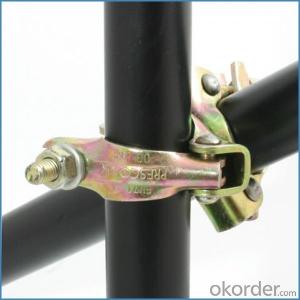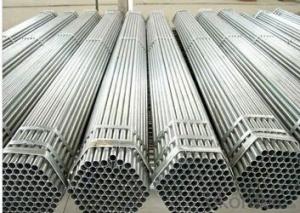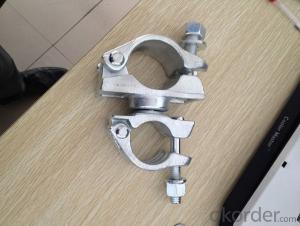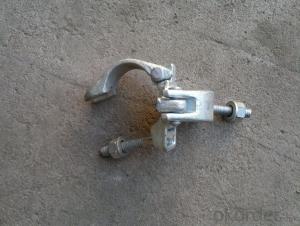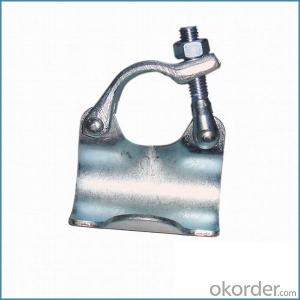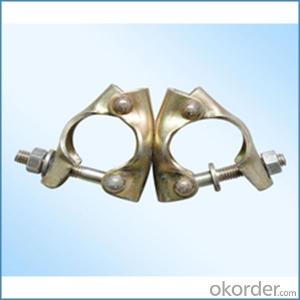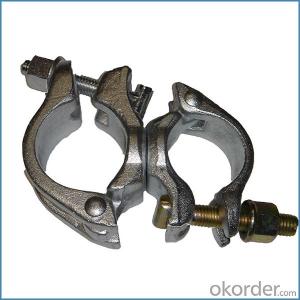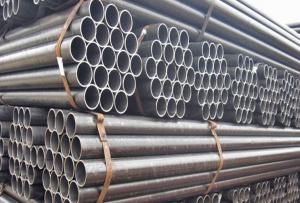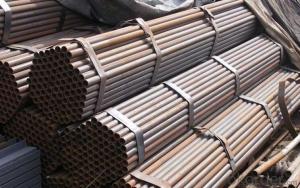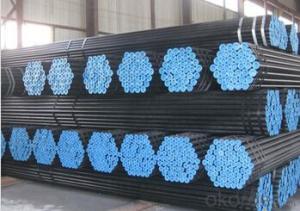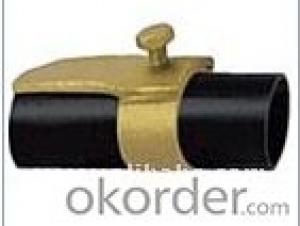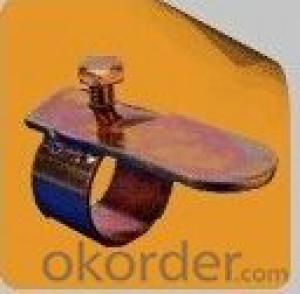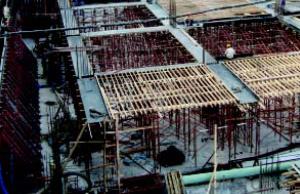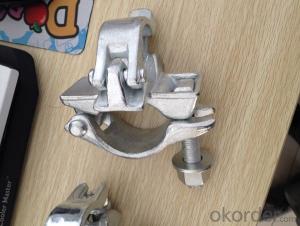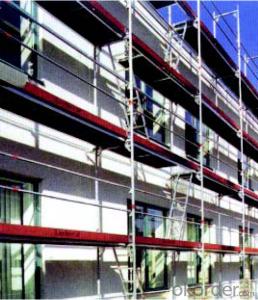Scaffold Coupler t Bolt British Type for Sale
- Loading Port:
- Tianjin
- Payment Terms:
- TT OR LC
- Min Order Qty:
- 1000 kg
- Supply Capability:
- 100000 kg/month
OKorder Service Pledge
OKorder Financial Service
You Might Also Like
Scaffold Coupler t Bolt British Type for Sale
Description
1.The scaffolding coupler is always used to connect the steel pipe as scaffolding system.
2.The often used coupler is swivel coupler and righ angle coupler .
3.We can provide types of scaffolding coupler according to your requirement.
4.Couoler can fix the 48.3mm scaffolding steel pipe tightly and make the whole scaffolding system more steadily.
5.Material:Q235 steel
6.Overall Size:48.3mm*48.3mm
7.Surface Finish: Galvanized/ Painted
8.Standard:BS1139,EN74
9.Package:25pcs/bag
10.Manufactuering as per customer requirements
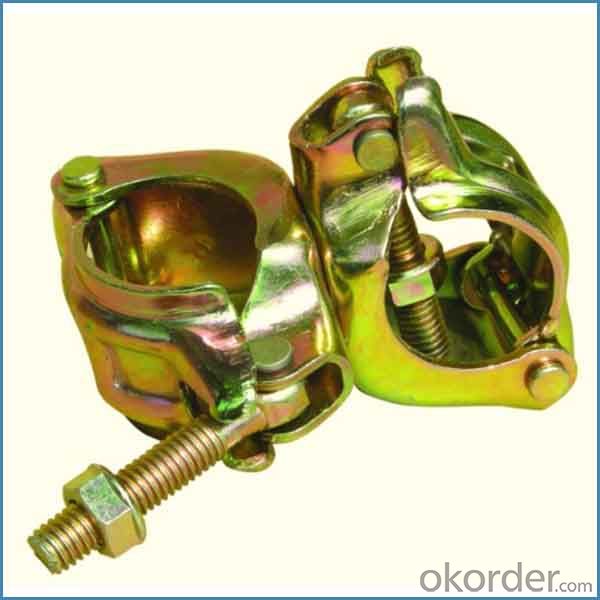
Feature
(1)Excellent Anti-Breaking—Cold Pressed Steel
(2)Outstanding Resistance Deformation
(3)Strong Anti-Dropping Ability
(4)Longtime USe
(5)Qualtity Guaranteed
(6)OEM Service
Photo
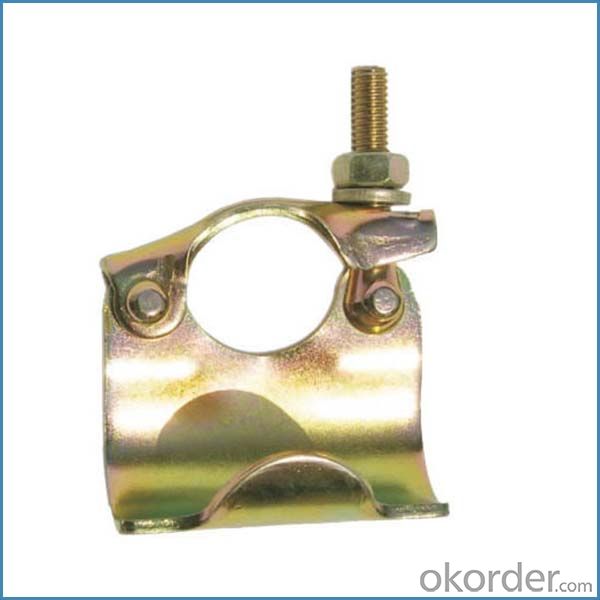
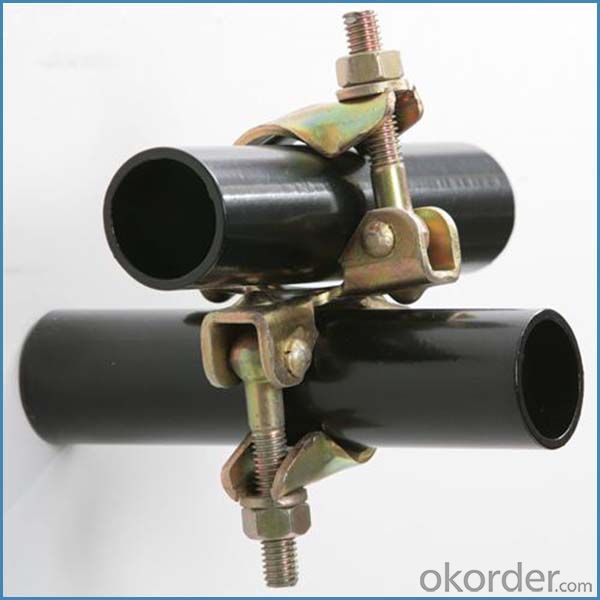
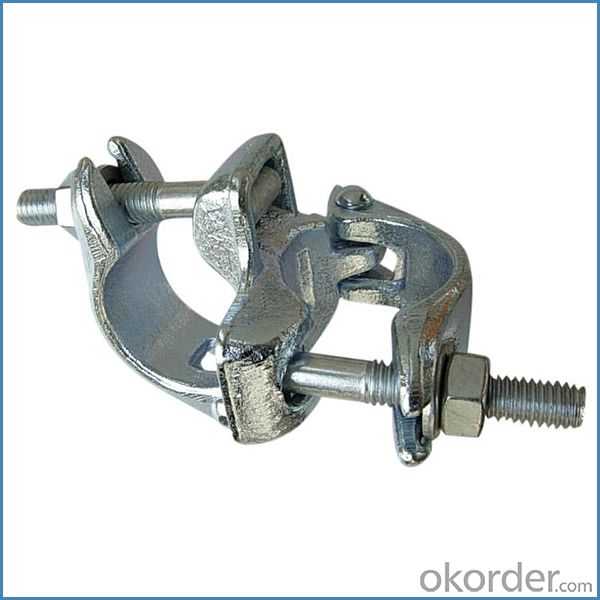
Parameter
| Material | Q235,345steel |
| Size | 48.3mm*48.3mm |
| Surface finish | Galvanized |
| Weight | 1.1kg around |
| Standard | BS1139,EN74 |
| Package | 25pcs/bag,steel pallet |
| Manufacture | As per customer requirement |
| Market | Africa, South America, the Middle East and Asia |
FAQ
Q: Are you a factory or trading company?
We are a state-owned corporation in China,dealing with various kinds of building materials.We have our holding subsidiaries.
Q: Where is your factory located? How can I visit there?
Our factory is located all around China.
Q: Can I get some samples?
Sample is free, customer only pay freight for the first time.
Q: Delivery?
10-30days. (5-15 containers)
Any question,feel free to contact us.
- Q:Are steel tube couplers adjustable?
- Yes, steel tube couplers are adjustable. They are designed to provide flexibility and allow for easy adjustment and alignment of steel tubes or pipes.
- Q:Are there any specific guidelines for the safe use of steel tube couplers in scaffolding near high-pressure or pressurized systems?
- 1. Conducting a thorough risk assessment is necessary before commencing work near high-pressure or pressurized systems. This assessment will help identify potential hazards and determine appropriate control measures, taking into account the proximity of the scaffolding to the system, potential impact forces, and the structural integrity of the scaffolding. 2. Only personnel who are competent and trained should be involved in assembling, disassembling, and using scaffolding near high-pressure or pressurized systems. These individuals should have a comprehensive understanding of the risks involved and be familiar with the specific guidelines and safety procedures. 3. It is crucial that the scaffolding structure is designed, erected, and inspected by competent individuals to ensure its stability and strength. Compliance with relevant standards and regulations for the use of steel tube couplers in scaffolding near high-pressure or pressurized systems is necessary to guarantee the structural integrity of the scaffolding. 4. Maintaining sufficient clearance between the scaffolding and high-pressure or pressurized systems is vital. The required clearance will vary depending on the specific system, but it is essential to prevent accidental contact or damage to the scaffolding caused by pressure release or burst. 5. Additional protective measures may be necessary to mitigate the risks associated with high-pressure or pressurized systems. These measures could include installing barriers, warning signs, or protective shields to safeguard the scaffolding and workers from potential hazards. 6. Establishing effective communication between personnel working on the scaffolding and those operating or maintaining the high-pressure or pressurized systems is crucial. This ensures that everyone is aware of potential risks and can take appropriate precautions to prevent accidents. 7. Regular inspections of the scaffolding and its components, including steel tube couplers, should be carried out to identify any signs of deterioration or damage. Promptly addressing any issues and replacing damaged components is necessary to maintain the safety of the scaffolding near high-pressure or pressurized systems. In conclusion, it is vital to adhere to these guidelines and any other specific recommendations provided by manufacturers, industry standards, or regulatory bodies to ensure the safe use of steel tube couplers in scaffolding near high-pressure or pressurized systems.
- Q:Can steel tube couplers be used for angled or curved connections in scaffolding?
- Yes, steel tube couplers can be used for angled or curved connections in scaffolding. Steel tube couplers are designed to connect two steel tubes together, providing a strong and secure connection. They are available in various types, such as swivel couplers, right-angle couplers, and sleeve couplers, which can accommodate different angles and curves in the scaffolding structure. These couplers are versatile and can be adjusted to fit the required angle or curve, ensuring a safe and stable scaffolding system. However, it is important to follow the manufacturer's guidelines and industry standards when using steel tube couplers for angled or curved connections to ensure proper installation and structural integrity.
- Q:so yesterday i had it pierced, surprisingly didn't hurt, even though she used freezing spray but yeah.but what i wanted to know was..1) how do i know what gauge it is? i know the bar is 38mm long the piercer gave me the packet it was in just in case i forgot, because i want to buy some barbells but i don't know what size to have? and the piercer said that i should go for a 36mm but i'm not sure, it doesn't seem to be big enough as it is. and the ball is about 4mm i think? dunno i used a ruler to measure it lmfao2) should i keep twisting it? i heard that you have to, to stop the skin growing over it but i read somewhere else that i shouldn't otherwise it will take longer to heal?3) to clean it, all i have done so far is rub around the pierced area with an ear bud, then like dunk it in a small tub of hot salty water for 5 minutes? is that enough? and should i use tea tree oil? and would i be able to use that even though i had it done not long ago?there might be more questions so keep checking:)
- 1. The chances are that it's going to be a 14g (1.6mm) 2. do not twist/play/move the jewelry! this is a BAD idea-- it will prolong healing time, destroy the fistula and bring in unwanted bacteria into the wound. 3. You can use tea tree oil, just make sure you dilute it in water beforehand. Keep doing the salt soaks and you should be fine, you can do them for 5-10 minutes so if you want to do them longer than 5 minutes, you can.
- Q:Can steel tube couplers be used for scaffolding structures that need to provide access to overhead or elevated areas?
- Yes, steel tube couplers can be used for scaffolding structures that need to provide access to overhead or elevated areas. Steel tube couplers are commonly used in scaffolding systems due to their strength and durability. They allow for the secure attachment of tubes and provide stability, making them suitable for supporting scaffolding structures that require safe access to overhead or elevated areas.
- Q:Are there any specific guidelines for the safe use of steel tube couplers in scaffolding near areas with excessive noise or vibrations?
- Indeed, there exist specific guidelines for the secure utilization of steel tube couplers in scaffolding in close proximity to regions with excessive noise or vibrations. When operating in such areas, it is of utmost importance to guarantee the stability and integrity of the scaffold structure. Here are a few recommendations to adhere to: 1. Opt for appropriate steel tube couplers: Carefully select couplers that are specifically designed for scaffolding purposes and have the ability to withstand high levels of noise or vibrations. Ensure that they meet the necessary safety standards and have been approved for usage in such conditions. 2. Perform a risk assessment: Prior to setting up the scaffold, evaluate the levels of noise and vibrations in the area. Identify potential hazards and assess the structural requirements based on these factors. 3. Employ robust scaffolding materials: Choose high-quality steel tubes that can endure excessive noise and vibrations without compromising the scaffold's integrity. Verify that the tubes are in good condition and receive proper maintenance. 4. Secure the connections: Guarantee that all couplers are securely fastened and locked in place. Regularly inspect the connections to detect any indications of loosening or movement caused by noise or vibrations. Strengthen the connections if necessary. 5. Consider additional stabilization measures: In regions with excessive noise or vibrations, it may be necessary to provide additional stabilization to the scaffold. This can involve utilizing diagonal braces or tie-ins to enhance the structure's stability. 6. Train workers and supply appropriate PPE: Educate workers about the potential risks associated with noise and vibrations and provide them with adequate training on safe working practices. Additionally, ensure that workers have access to suitable personal protective equipment (PPE) to minimize exposure to excessive noise or vibrations. 7. Monitor noise and vibration levels: Implement a monitoring system to regularly assess and measure the noise and vibration levels in the vicinity of the scaffold. This will aid in identifying any changes or potential risks that may require adjustments to the scaffold setup. By adhering to these guidelines, scaffolding near areas with excessive noise or vibrations can be securely utilized, ensuring the stability and safety of both the structure and the workers involved.
- Q:Are steel tube couplers compatible with scaffolding safety nets and barriers?
- Yes, steel tube couplers are compatible with scaffolding safety nets and barriers. They are designed to securely fasten tubes together, providing a stable and reliable connection, which is essential for supporting safety nets and barriers in scaffolding systems.
- Q:What are the different types of steel tube couplers available?
- There are several different types of steel tube couplers available, each with its own unique design and purpose. 1. Sleeve Couplers: Sleeve couplers are the most common type of steel tube couplers. They consist of a cylindrical sleeve with internal threads on both ends. These couplers are used to join two steel tubes together by screwing the sleeve onto the threaded ends of the tubes. 2. Swivel Couplers: Swivel couplers are used to connect two steel tubes at any angle. They have a swivel mechanism that allows the tubes to be positioned in different orientations. This type of coupler is often used in scaffolding applications, where flexibility in positioning is required. 3. Right-Angle Couplers: Right-angle couplers are designed to connect two steel tubes at a 90-degree angle. They have a fixed angle and are commonly used in construction projects where stability and rigidity are essential. 4. Putlog Couplers: Putlog couplers are used to connect steel tubes to walls or other structural elements. They have a flat plate with holes that are used to secure the tube to the surface. These couplers are often used in scaffolding systems to provide support and stability. 5. Half Couplers: Half couplers are designed to connect a steel tube to a flat surface, such as a wall or a beam. They have a flat plate with an opening that allows the tube to be inserted and secured with bolts or screws. These couplers are commonly used in construction projects where a tube needs to be attached to a fixed structure. 6. Beam Clamps: Beam clamps are specialized couplers used to connect steel tubes to beams or other overhead structures. They have a clamp mechanism that allows them to be securely attached to the beam, providing a stable connection point for the tube. These are just a few examples of the different types of steel tube couplers available. The choice of coupler depends on the specific application and the requirements of the project. It is essential to select the appropriate coupler to ensure a safe and secure connection between steel tubes.
- Q:How do you inspect steel tube couplers for any signs of wear or damage?
- To inspect steel tube couplers for signs of wear or damage, it is essential to visually examine the couplers thoroughly. Look for any visible cracks, dents, or deformation on the surface of the couplers. Additionally, check for any corrosion, rust, or discoloration that may indicate deterioration. It is also crucial to ensure that the couplers are properly aligned and securely fastened. Regular maintenance and periodic inspections are crucial to identify any potential issues and ensure the integrity of the steel tube couplers.
- Q:Are steel tube couplers resistant to vibration or shaking in scaffolding structures?
- Yes, steel tube couplers are resistant to vibration or shaking in scaffolding structures. Steel is a strong and durable material that can withstand external forces, including vibrations and shaking. Steel tube couplers are designed to provide a secure connection between scaffolding tubes, ensuring stability and integrity of the structure. These couplers are specifically engineered to minimize movement and prevent any loosening or dislodging caused by vibrations or shaking. Additionally, steel tube couplers undergo rigorous testing to ensure their resistance to various forces, including vibrations, making them a reliable choice for scaffolding structures.
1. Manufacturer Overview |
|
|---|---|
| Location | |
| Year Established | |
| Annual Output Value | |
| Main Markets | |
| Company Certifications | |
2. Manufacturer Certificates |
|
|---|---|
| a) Certification Name | |
| Range | |
| Reference | |
| Validity Period | |
3. Manufacturer Capability |
|
|---|---|
| a)Trade Capacity | |
| Nearest Port | |
| Export Percentage | |
| No.of Employees in Trade Department | |
| Language Spoken: | |
| b)Factory Information | |
| Factory Size: | |
| No. of Production Lines | |
| Contract Manufacturing | |
| Product Price Range | |
Send your message to us
Scaffold Coupler t Bolt British Type for Sale
- Loading Port:
- Tianjin
- Payment Terms:
- TT OR LC
- Min Order Qty:
- 1000 kg
- Supply Capability:
- 100000 kg/month
OKorder Service Pledge
OKorder Financial Service
Similar products
New products
Hot products
Hot Searches
